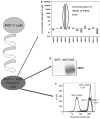Molecular mechanisms of drug resistance in single-step and multi-step drug-selected cancer cells
- PMID: 19949921
- PMCID: PMC3099236
- DOI: 10.1007/978-1-60761-416-6_5
Molecular mechanisms of drug resistance in single-step and multi-step drug-selected cancer cells
Abstract
Multidrug resistance (MDR) remains one of the key determinants in chemotherapeutic success of cancer patients. Often, acquired resistance is mediated by the overexpression of ATP-binding cassette (ABC) drug transporters. To study the mechanisms involved in the MDR phenotype, investigators have generated a variety of in vitro cell culture models using both multi-step and single-step drug selections. Sublines produced from multi-step selections have led to the discovery of several crucial drug transporters including ABCB1, ABCC1, and ABCG2. Additionally, a number of mechanisms causing gene overexpression have been elucidated. To more closely mimic in vivo conditions, investigators have also established MDR sublines with single-step drug selections. Here, we examine some of the multi-step and single-step selected cell lines generated to elucidate the mechanisms involved in the development of MDR in cancer cells.
Figures


References
-
- Jemal A, Siegel R, Ward E, Hao Y, Xu J, Murray T, Thun MJ. Cancer Statistics, 2008. CA Cancer J Clin. 2008;58:71–96. - PubMed
-
- Gottesman MM. Mechanisms of cancer drug resistance. Annu Rev Med. 2002;53:615–627. - PubMed
-
- Dean M, Annilo T. Evolution of the ATP-Binding cassette (ABC) transporter superfamily in vertebrates. Annu Rev Genomics Hum Genet. 2005;6:123–142. - PubMed
-
- Dean M, Fojo T, Bates S. Tumour stem cells and drug resistance. Nat Rev Cancer. 2005;5:275–284. - PubMed
-
- Gottesman M, Ambudkar S. Overview: ABC transporters and human disease. J Bioenerg Biomembr. 2001;33:453–458. - PubMed
Publication types
MeSH terms
Substances
Grants and funding
LinkOut - more resources
Full Text Sources

